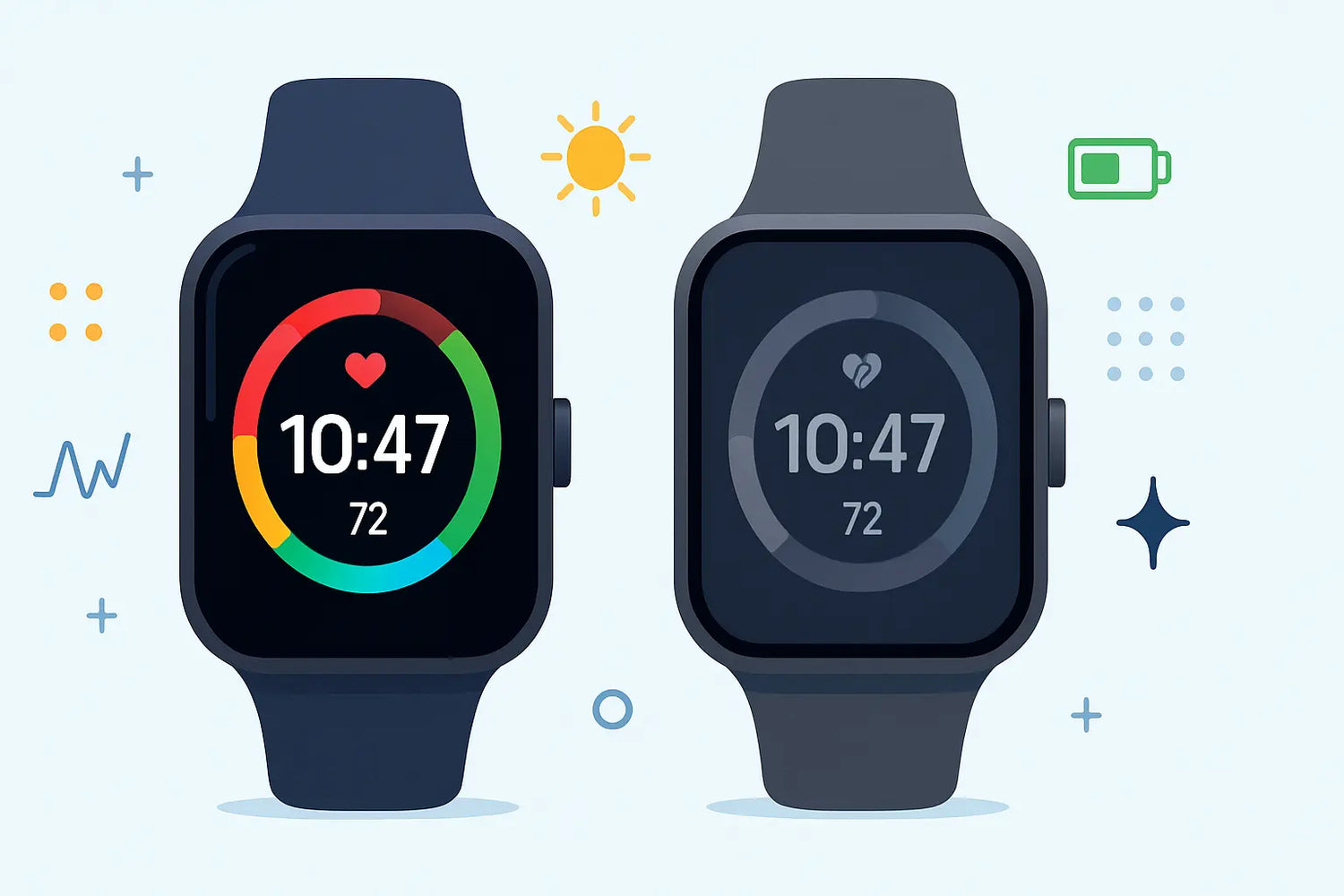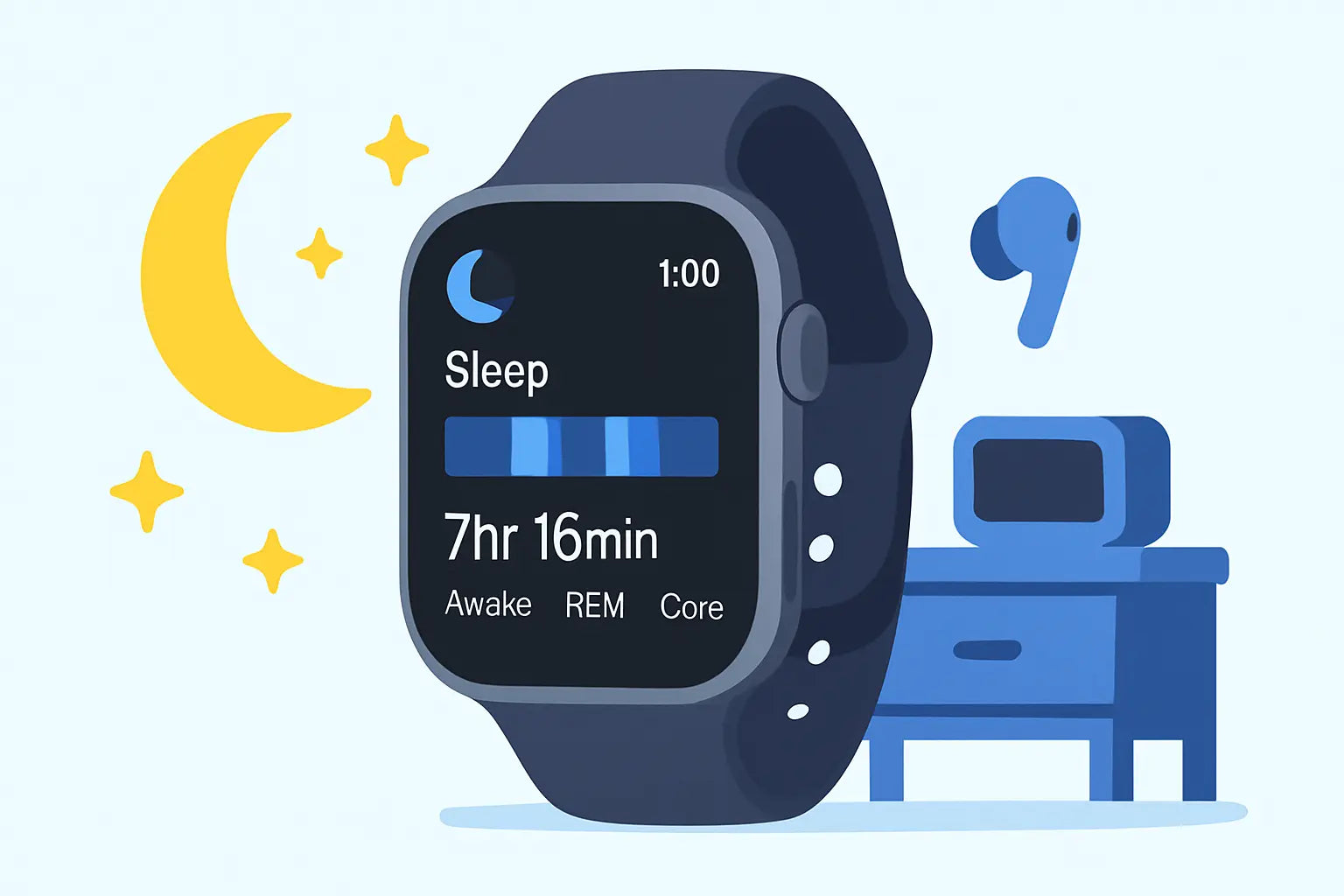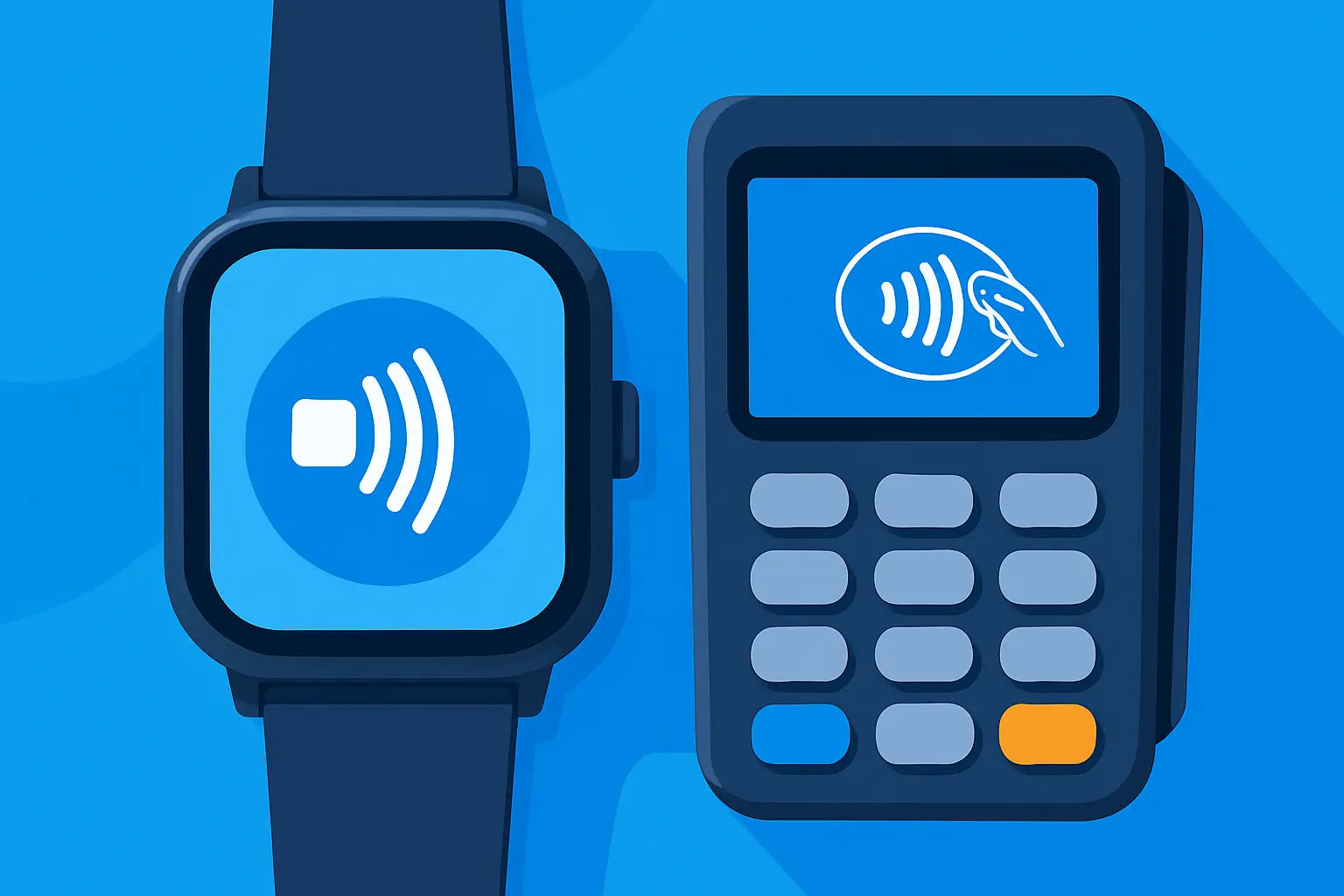AMOLED smartwatch screens light each pixel individually for perfect blacks, ultra high contrast, and vivid colours, while LCD uses a backlight that reduces contrast but can be cheaper and consistent in bright whites. AMOLED saves power on dark faces; LCD can use more with always-on backlight.
Quick primer on AMOLED vs LCD
How each creates light
AMOLED uses organic diodes that emit light per pixel, so black pixels draw near-zero power. LCD blocks a white backlight through colour filters to form images, so even dark scenes need illumination. This fundamental difference drives contrast, power, thickness, and flexibility.
Contrast and colour accuracy
AMOLED achieves effectively infinite contrast - black is 0 nits next to bright pixels. LCD typically delivers around 1000:1 to 2000:1 contrast, which flattens shadow detail. Modern AMOLED panels also cover a wide gamut such as DCI-P3, aiding lifelike watch faces and rich mapping screens.
Brightness and outdoor use in the UK
Many AMOLED watches now reach roughly 1000 to 3000 nits peak, improving summer legibility. Standard IPS LCDs on watches often sit near 500 to 1000 nits, though transflective LCDs excel under direct sun. In overcast British light, both are readable, but AMOLED wins for deep blacks in dim pubs and late trains.
Are AMOLED screens better than LCD?
Pros where AMOLED wins
- True blacks, infinite contrast
- Lower power on dark faces
- Thinner, flexible stack
- Fast response times
- Vivid, wide colour
When LCD or MIP makes sense
- Sunlit fitness readability
- Extremely long battery
- Lower purchase cost
- Minimal burn-in risk
- Always-on white widgets
Real-world smartwatch examples in 2025
Apple Watch 11 display traits
Apple Watch 11 uses an LTPO OLED - a form of AMOLED - enabling always-on at variable refresh to save power. Expect crisp text, perfect blacks for sleep tracking, and smooth animations in watchOS. Typical day-long endurance remains achievable even with always-on enabled if brightness is sensible.
Samsung Galaxy Watch 8 display
Samsung Galaxy Watch 8 uses Super AMOLED, known for punchy colours and high brightness. Samsung’s high frequency dimming helps reduce perceived flicker at low brightness. In UK sunlight, peak boost helps maps and notifications pop during a run.
Garmin options - AMOLED vs MIP
Garmin Venu 3 and Forerunner 965 use AMOLED for rich data fields and detailed maps. Fenix and Instinct families rely on transflective MIP LCD, which sips power and stays superbly visible outdoors. Multi-day hikers across Snowdonia often prefer MIP for 10 to 20 day battery potential.
Battery life and always-on display
Typical runtimes and numbers
AMOLED everyday watches commonly last 1 to 3 days with always-on, and longer with raise-to-wake only. Performance models with efficient chipsets push 3 to 7 days, while MIP LCD adventure watches can stretch well past a week. Always-on can trim battery by about 20 to 40 percent depending on brightness and content.
Watch faces and power tips
On AMOLED, dark watch faces cut power because black pixels are off. On LCD, a dark face does not save as much because the backlight still runs. Keep brightness on auto, reduce complications that update per second, and avoid static elements to balance longevity and burn-in risk.
Eye comfort, PWM, and longevity
PWM flicker considerations
Many AMOLED panels dim using PWM, commonly in the 240 Hz to 960 Hz range. Sensitive users may prefer higher PWM frequencies or DC-dimming modes when available. LCDs typically rely on constant backlights or high-frequency PWM, which may be more comfortable for some eyes at low brightness.
Burn-in and image retention
AMOLED can experience image retention if static elements stay for hundreds of hours, though modern mitigation shifts pixels subtly. Manufacturers also schedule pixel refresh cycles and vary UI layouts to spread wear. LCD avoids burn-in, making it safer for static white complications that stay on all day.
What display type is best for smartwatches?
Fitness-first and outdoor users
If you run, cycle, or hike in bright conditions, transflective LCD or very bright AMOLED both work, but MIP LCD maximises daylight clarity and endurance. For multi-day UK treks without charging, MIP remains unmatched. If you want rich maps and workouts with colour gradients, AMOLED offers visual advantages.
Everyday, office, and style
For commuters and office use, AMOLED’s deep blacks elevate watch faces and notifications. It pairs well with always-on designs that look like classic watches in dim interiors. LCD can still suit budget buyers who prioritise utility and value.
Spec comparison table
| Characteristic | AMOLED | LCD (IPS or MIP) |
|---|---|---|
| Light source | Self-emissive pixels | Backlight through filters |
| Contrast ratio | ~Infinite | ~1000:1 to 2000:1 |
| Black level | 0 nits per-pixel off | Backlight glow present |
| Peak brightness | ~1000 to 3000 nits | ~500 to 1000 nits |
| Outdoor readability | High with boost | IPS fair, MIP excellent |
| Power - dark UI | Very efficient | Backlight still on |
| Power - bright UI | Higher draw | Similar draw |
| Always-on display | LTPO reduces drain | Backlight or transflective |
| Thickness | Thin, flexible stack | Thicker with backlight |
| Response time | ~1 to 5 ms | ~5 to 20 ms |
| Colour gamut | Wide, vivid | Good to very good |
| PWM flicker | Common, 240-960 Hz | Less noticeable or higher |
| Burn-in risk | Low but present | Negligible |
| Longevity | Blue subpixel ages | Stable over years |
| Cost | Generally higher | Generally lower |
Buying considerations for UK shoppers
Warranty, service, and weather
Check UK warranty terms for screen defects, as burn-in is often excluded. Wet British commutes demand solid water resistance and glove-friendly raise-to-wake. Cold mornings can reduce battery efficiency, so plan for a top-up on longer days.
Accessories and protection
A tempered protector can reduce scuffs without killing brightness, especially on AMOLED. Pair your Apple Watch with Apple straps and Watch accessories for comfort and protection. Choose darker watch faces on AMOLED for commuting to extend battery through the evening.
FAQs
Does AMOLED always use less power than LCD?
Only with darker content, because black pixels turn off. With bright white screens, AMOLED can draw as much or more than LCD. Smartwatch UIs are usually dark to keep AMOLED efficient.
Will my watch get burn-in?
It is uncommon with modern mitigations like pixel shifting, varied complications, and refresh routines. Avoid leaving a bright static face at max brightness for weeks. Rotate faces and use auto-brightness to minimise risk.
Is LCD unreadable at night?
No, backlights make LCD perfectly readable in darkness. However, blacks will appear grey compared to AMOLED. Many users prefer AMOLED at night because of deeper contrast.
Which is better for mapping and photos?
AMOLED usually, due to higher contrast and wider colour. Fine details in maps and watch faces appear more lifelike. Brightness boosts also help outdoors when navigating.
Do Apple Watch 11 and Galaxy Watch 8 use AMOLED?
Apple uses an LTPO OLED panel and Samsung uses Super AMOLED branding. Both are self-emissive with deep blacks and smooth animations. They are prime examples of modern AMOLED-class smartwatch displays.
Conclusion
AMOLED and LCD differ in how they create light: AMOLED pixels emit their own light for true blacks and massive contrast, while LCD relies on a backlight that limits black depth but offers endurance and value. For most UK users, AMOLED looks better and feels more premium, while transflective LCD excels for ultra-long, outdoor-focused battery life.




Leave a comment
All comments are moderated before being published.
This site is protected by hCaptcha and the hCaptcha Privacy Policy and Terms of Service apply.